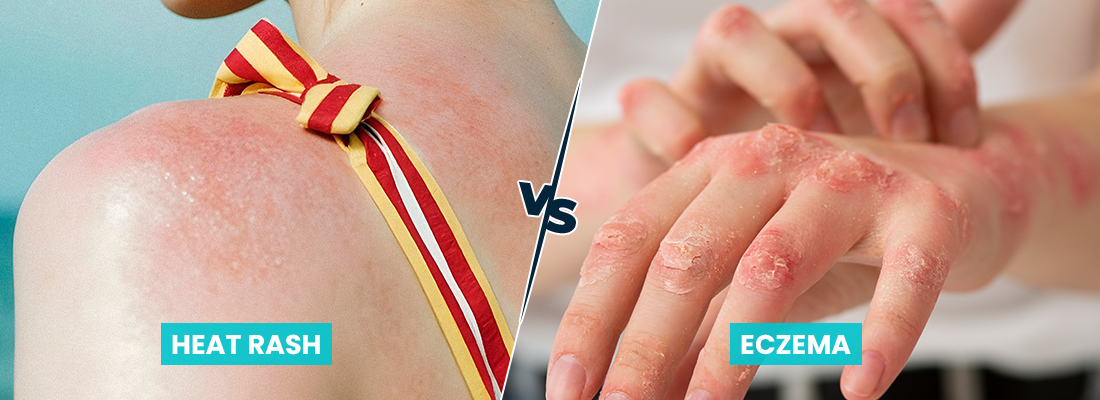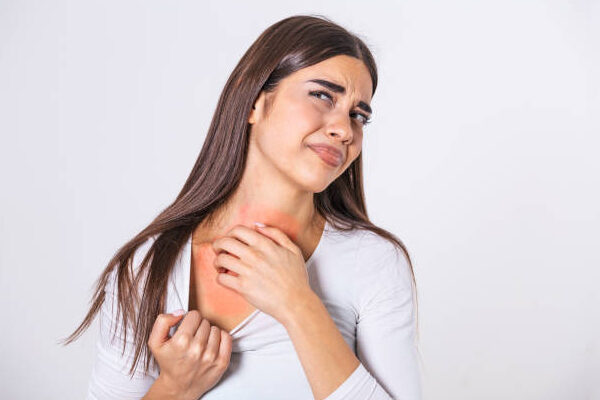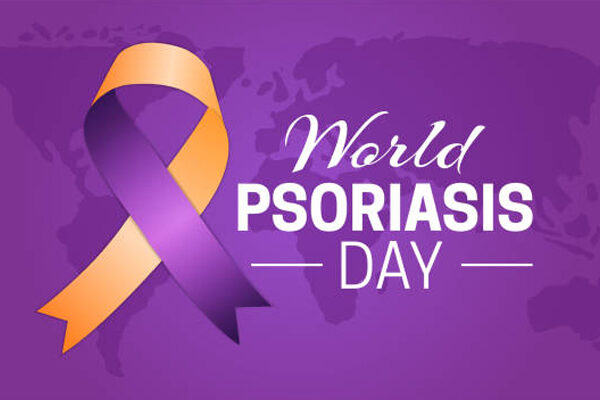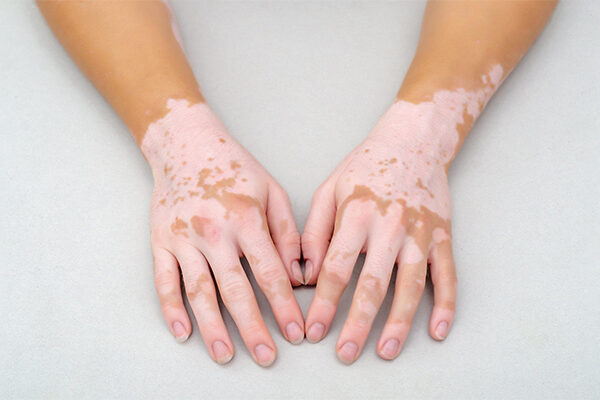
It’s summer, and that red, itchy patch on your skin won’t go away. You’re sweating, uncomfortable, and maybe a little confused. Is it just irritation from the heat, or is it something more chronic? This brings us to the much-searched comparison of heat rash vs. eczema, a distinction that matters more than you think.
What is Heat Rash?
Also called miliaria or prickly heat, heat rash is a temporary skin condition that typically occurs when sweat becomes trapped in the sweat ducts. It is more common in hot, humid climates and often affects babies, though adults can get it too.
What Does Heat Rash Look Like?
What does a heat rash look like? It usually appears as tiny red bumps or clear fluid-filled blisters that feel prickly or itchy. Common areas include the neck, chest, back, and folds of the skin. These spots can feel like sandpaper or resemble goosebumps.
What is Eczema?
Eczema, medically known as atopic dermatitis, is a chronic inflammatory skin condition characterized by dry, scaly, and itchy patches of skin. It can be triggered by allergens, irritants, stress, or genetic factors and often requires ongoing management.
The Big Question: Heat Rash vs. Eczema
Let’s get into the differences and the reasons why so many people misinterpret one for the other.
| Feature | Heat Rash | Eczema |
|---|---|---|
| Duration | Temporary (resolves in a few days) | Chronic (recurring and long-term) |
| Appearance | Small red or clear bumps | Dry, flaky, thickened patches |
| Triggers | Heat, sweat, humidity | Allergens, stress, soaps, fabrics |
| Location | Skin folds, neck, back | Hands, face, knees, elbows |
| Age Group | Common in infants and adults in summer | Can begin in infancy or later in life |
| Treatment | Cooling, anti-itch creams | Can begin in infancy or later in life |
In the comparison of heat rash vs. eczema, the tradeoff lies in recognizing the acute nature of heat rash versus the chronic nature of eczema. Treating one like the other can delay proper healing.
How Do You Know the Difference? Visual Clues Matter

A picture says a thousand words. That’s why understanding eczema heat rash pictures can help patients and even physicians narrow down a diagnosis.
- Heat rash photos usually show clusters of tiny, inflamed bumps.
- Eczema images reflect scaly, rough, often thickened patches that may ooze or crust over after scratching.
Seeing and comparing eczema heat rash pictures can provide a clearer sense of what your skin might be going through.
Here’s a tip: If the rash improves with cool air and less sweating, it’s likely a heat rash. If it persists for weeks and comes with dry, flaky skin, eczema could be the culprit.
Interesting Fact:
According to the American Academy of Dermatology, up to 25% of children and 10% of adults in the U.S. suffer from eczema. In contrast, heat rash affects nearly everyone at some point, especially in hot climates or during intense workouts.
What Does the Latest Research Say?
A 2023 study published in Dermatitis journal noted that filaggrin gene mutations responsible for maintaining the skin barrier are commonly associated with eczema but not with heat rash. This genetic insight helps in the long-term diagnosis and targeted treatment of eczema.
Meanwhile, research published in Clinical, Cosmetic and Investigational Dermatology (2022) found that heat rash is significantly more likely during heatwaves and in people who wear synthetic clothing for prolonged periods, such as athletes or outdoor workers.
These distinctions highlight why comparing heat rash vs. eczema isn’t just academic; it has real treatment implications.
Why Misdiagnosis Matters
If you think eczema is just a heat rash and ignore it, you might miss the window for early intervention with topical steroids or immune therapies. Conversely, if you treat a heat rash with strong eczema medications, you may irritate the skin further. Understanding heat rash vs. eczema can prevent discomfort, improper treatment, and prolonged flare-ups.
Customizing Treatment Approaches Based on Diagnosis
When comparing heat rash vs. eczema, treatment plans must reflect the nature of the condition. While one resolves quickly, the other requires long-term attention.
Treatment for Heat Rash:
| Treatment Type | Examples |
|---|---|
| Cooling the Skin | Use fans, AC, or cool compresses to reduce sweating |
| Topical Applications | Calamine lotion, aloe vera, hydrocortisone cream (mild) |
| Clothing Adjustments | Wear breathable, loose cotton fabrics |
| Hygiene Measures | Daily showers, avoiding oily or occlusive creams |
Heat rash often disappears within a few days, especially if the skin is kept cool and dry.
Treatment for Eczema:
| Treatment Type | Examples |
|---|---|
| Moisturizing | Thick creams or ointments like petroleum jelly, ceramide creams |
| Topical Steroids | Low to mid-potency corticosteroids like hydrocortisone or triamcinolone |
| Non-Steroidal Options | Tacrolimus or pimecrolimus (topical calcineurin inhibitors) |
| Systemic Treatments | Biologics like Dupilumab (for moderate to severe cases) |
| Lifestyle Management | Allergen avoidance, stress reduction, and gentle skincare routines |
Chronic eczema needs consistent skincare and occasional flare-up management.
Interesting fact: Studies show that moisturizing the skin twice daily can reduce eczema flare-ups by up to 50% in children.
Prevention Strategies
Whether its heat rash vs. eczema, prevention remains a powerful tool. The strategies for both, though overlapping in some areas, differ based on the condition’s cause.
For Heat Rash:
- Stay in cool environments
- Avoid tight or synthetic clothing
- Shower and pat dry after sweating
- Use fans or air conditioning to reduce body heat
For Eczema:
- Avoid known allergens and irritants (e.g., fragrance, harsh soaps)
- Use hypoallergenic laundry detergents
- Maintain consistent moisturizing routines
- Consider allergy testing to identify triggers
When people compare heat rash vs. eczema, they often underestimate how a few small adjustments, like switching to cotton clothes or fragrance-free skincare, can drastically change outcomes.
Visual Cues: The Role of Pictures
Let’s revisit this common confusion: “Is this dry, itchy rash on my neck eczema or just a heat rash?” Here’s where understanding what does heat rash looks like and seeing eczema heat rash pictures becomes essential.
Visual Differences
| Treatment Type | Examples | Examples |
|---|---|---|
| Bumps | Small, pinpoint red or clear dots | Larger, scaly, inflamed patches |
| Texture | Prickly or bumpy | Thickened, cracked, or weeping |
| Color | Pink or red with sweat trapped | Red to brownish gray depending on severity |
| Area | Folds, neck, back | Face, arms, behind knees, hands |
By looking at eczema heat rash pictures, individuals can develop a clearer idea of which condition they may be facing, enabling more accurate self-care or guidance when visiting a healthcare provider.
Pro Tip: Always take a photo of your rash during flare-ups to track progress or worsening symptoms. This can be valuable for dermatologists.
Final Thoughts: Why Differentiating Matters
Distinguishing heat rash vs. eczema is more than an academic exercise; it guides treatments, prevents complications, and promotes skin health.
Understanding what does heat rash looks like and referring to eczema heat rash pictures empowers individuals to manage their skin conditions confidently.
Remember: Your skin speaks. Learning its language could be the key to your comfort.
Whether it’s a short-lived rash after a hot day or a recurring battle with eczema, your skin deserves proper care and now, you’re one step closer to giving it just that.





